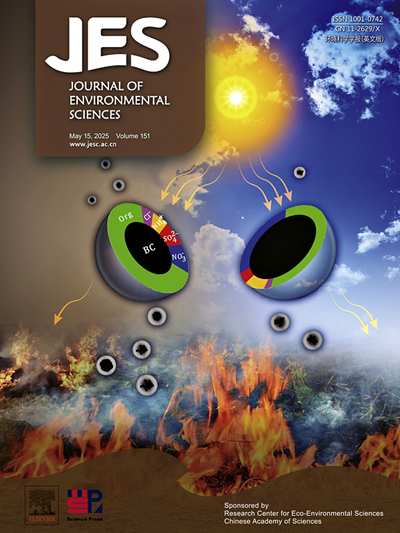钌簇包被富铝沸石有效催化消除1,2-二氯乙烷
IF 5.9
2区 环境科学与生态学
Q1 ENVIRONMENTAL SCIENCES
引用次数: 0
摘要
制备了不同制备方法或载体的钌基催化剂,并应用于1,2-二氯乙烷(1,2- dce)的高效催化去除。首先发现通过调节Ru与载体的相互作用可以提高催化剂的氧化还原能力和抗氯能力。与其他载体和常规浸渍方法相比,原位封装策略合成的Ru@ZSM-5催化剂具有优异的低温催化性能(T50 = 262℃,T90 = 327℃),长期测试稳定性好,目标产物理想。载体的酸度、比表面积以及与贵金属的相互作用对催化活性有显著影响,孔隙结构内的Ru团簇与框架Al基团结合更紧密,促进了氧化行为。该包封策略还显著提高了Ru的分散性,从而促进了氧活化和含cl的挥发性有机化合物(CVOCs)的深度氧化,并保留了大量Brønsted酸位点,优化了CVOCs的水解机制。随后,金属氧化还原与酸度之间的协同效应得到极大优化,从而极大地促进了1,2- dce氧化的催化效率。本文章由计算机程序翻译,如有差异,请以英文原文为准。

Ru clusters encapsulated with Al-rich zeolite for efficiently catalytic elimination of 1,2-dichloroethane
The Ru-based catalysts with different preparation methods or supports were achieved and applied in efficiently catalytic elimination of 1,2-dichloroethane (1,2-DCE). It was firstly found that the redox ability and chlorine resistance of the catalyst could be improved by regulating the interaction between Ru and supports. Compared with other supports and conventionally impregnated methods, the Ru@ZSM-5 catalyst synthesized by the in-situ encapsulation strategy exhibited an excellent low-temperature catalytic performance (T50 = 262 °C, T90 = 327 °C), superior stability in long-term test as well as ideal target products. The acidity, specific surface area, and interaction with precious metals of the supports have significant influences on the catalytic activity, and the Ru clusters inside the pore structures are more closely bound to the framework Al species, which promotes the oxidation behavior. The encapsulation strategy also significantly improves the Ru dispersion thereby facilitates oxygen activation as well as Cl-containing volatile organic compounds (CVOCs) deep oxidation, and preserves large amounts of Brønsted acid sites to optimize the hydrolysis mechanism for purification of CVOCs. Subsequently, the synergistic effect between metal redox and acidity is greatly optimized, thus extremely promoting the catalytic efficiency of 1,2-DCE oxidation.
求助全文
通过发布文献求助,成功后即可免费获取论文全文。
去求助
来源期刊

Journal of Environmental Sciences-china
环境科学-环境科学
CiteScore
13.70
自引率
0.00%
发文量
6354
审稿时长
2.6 months
期刊介绍:
The Journal of Environmental Sciences is an international journal started in 1989. The journal is devoted to publish original, peer-reviewed research papers on main aspects of environmental sciences, such as environmental chemistry, environmental biology, ecology, geosciences and environmental physics. Appropriate subjects include basic and applied research on atmospheric, terrestrial and aquatic environments, pollution control and abatement technology, conservation of natural resources, environmental health and toxicology. Announcements of international environmental science meetings and other recent information are also included.
 求助内容:
求助内容: 应助结果提醒方式:
应助结果提醒方式:


